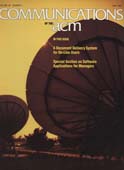May 1983 - Vol. 26 No. 5

Features
DOCUMENTS: an interactive online solution to four documentation problems
An adequate delivery system for user documentation addresses the problems of easy access, versatile publication, convenient administration, and good document quality. At the National Magnetic Fusion Energy Computer Center the DOCUMENT program helps solve these problems by providing a high level of service through strategies that can readily be exported to other contexts. Dividing machine-readable documents into keyword windows permits fully online, subject-oriented access to all passages. An adaptive, three-tier user interface extends flexible viewing control to novices and experts alike. DOCUMENT also supports online subject, title, and date catalogs, and provides on-demand output of hardcopy and microfiche. Several other document delivery systems are compared with DOCUMENT, and all have more rigid human interfaces, more structural display units for text, or more cumbersome output options.
Three papers from the third international conference on information systems: introduction
The International Conference on Information Systems provides an annual forum for keeping abreast of the latest trends and developments in IS research. The conference is sponsored by the TIMS College on Information Systems and the Society for Information Management in cooperation with ACM SIGBDP.
The Third International Conference on Information Systems was held December 13-15, 1982, in Ann Arbor, Michigan, with Alan G. Merten as chairman. Two papers from that conference have been published in recent issues, one by Ahmed S. Zaki in February and one by Margrethe H. Olson in March. They were concerned with the impact of information systems on organizations and society. The following three papers discuss new methodological approaches to the development and use of information systems.
Abdel-Hamid and Madnick focus on the problem of estimating resource requirements and schedules for software development projects. They use System Dynamics, a tool for modeling systems consisting of multiple, interacting feedback loops, to explore this problem. Their results show that policies often built into the project management process can assure that projects will fail to meet their scheduled completion, regardless of the accuracy of resource requirement and project size estimates.
Hart Will explores the idea of a single, unified interface to provide auditors with the access they need in today's computer-based accounting environment. Instead of the proliferation of audit software seen so far, he suggests that a common language for accessing data, programs, and text can be developed. He describes the design of such a language and speculates about its likely impact.
Mason and Carey's paper is concerned with the area of information systems design. They present an Architecture-Based Methodology for prototyping interactive information systems, derived from an analogy to the architectural approach to designing buildings or other physical structures. They discuss both the special role of “architect” and the tools required to support this approach to system design, including one commercially available program product.
The dynamics of software project scheduling
Software project scheduling is one of the major problem areas faced by software project managers today. While several quantitative software project resource and schedule estimation methods have been developed, such techniques raise some important, but as yet unresolved, dynamic issues. A systems dynamics (SD) approach is used to analyze several key dynamic software project scheduling issues.
Prototyping interactive information systems
Applying prototype-oriented development processes to computerized application systems significantly improves the likelihood that useful systems will be developed and that the overall development cycle will be shortened. The prototype development methodology and development tool presented here have been widely applied to the development of interactive information systems in the commercial data processing setting. The effectiveness and relationship to other applications is discussed.
ACL: a language specific for auditors
Audit software is essential for accountants. The software should be written to consolidate the audit support functions into a common language for management information systems (MIS). ACL (Audit Command Language) is a prototype language for designing a feasible interactive conversational language for auditing purposes.
A general-purpose algorithm for analyzing concurrent programs
Developing and verifying concurrent programs presents several problems. A static analysis algorithm is presented here that addresses the following problems: how processes are synchronized, what determines when programs are run in parallel, and how errors are detected in the synchronization structure. Though the research focuses on Ada, the results can be applied to other concurrent programming languages such as CSP.
Math proficiency: a key to success for computer science students
A computer science aptitude predictor was administered to students enrolled in a first technical course in computer science to determine potential for success. The study revealed significant differences in the scoring between students who withdrew from the course and those students who did not. The causes for the differences all related to the students' mathematical background: high school performance, previous computer science education, and the number of college mathematics courses taken.



